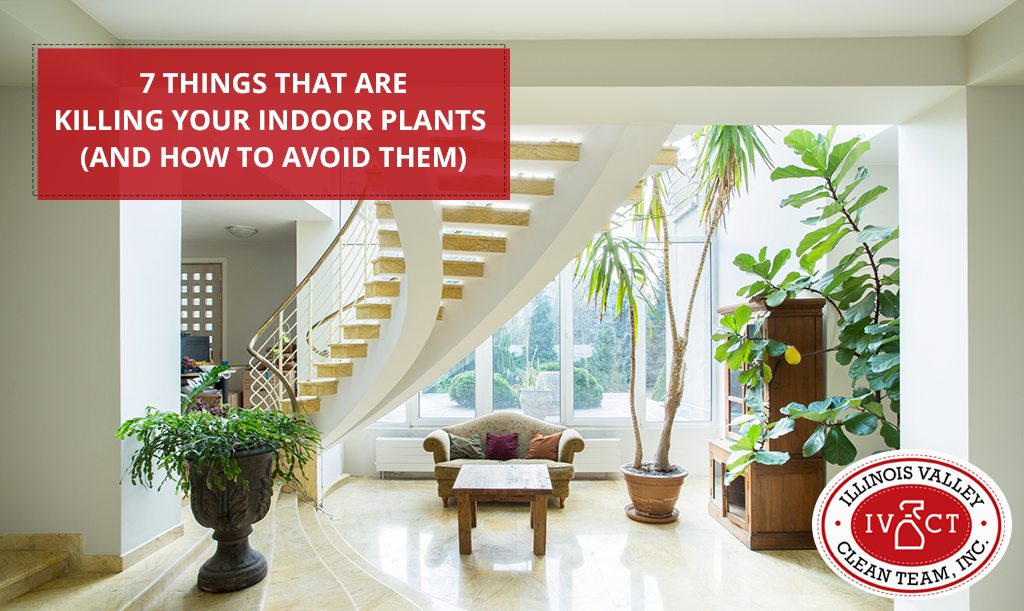Are you tired of doing a million little things to save money every month to no avail? Our 5 tips on saving money with the big picture stuff will help your finances get back on their feet.

Illinois Valley House Cleaning Services | IV Clean Team, Inc.
Home cleaning, window cleaning, gutter cleaning, pressure washing service in Peru, LaSalle, Oglesby, Ottawa, Spring Valley, Utica, Mendota, Illinois
Are you tired of doing a million little things to save money every month to no avail? Our 5 tips on saving money with the big picture stuff will help your finances get back on their feet.


Even if you buy a couple of so-called indoor plants for beginners, you might find yourself with a dead plant in its pot a couple of weeks later, again! What are you doing wrong? Well, it could be a plethora of things. Each type of plant has a specific set of conditions that need to be met for them to thrive, even if they are “for beginners,” but they also share some fundamental needs that anyone can master.
We made this list of basic plant-care tips so you can learn how not to kill your houseplants anymore. It’s all about putting in some time, patience, and the right amount of everything. Good luck!
1. Watering and pots are the first steps
There are two skills that anyone who wishes to keep plants in their house should master: Watering correctly and using the right pots. Many experts agree that over and underwatering are the number one reason why houseplants die before their time, and pots play a big role in that as well. The trick is to stick your finger in the soil; if it’s dry, time for water, but if it’s damp, let it be. Once a week should be enough, but remember to only water near the root of the plant, as watering the leaves directly can cause them to stain or rot.
Moving onto pots, have you ever worn too-small shoes for your feet? It’s the same for plants! Pots are not “one size fits all”, and many types of plant will need to be re-potted as time goes on and their roots get bigger. Not doing so can cause your plant to become rootbound, which can also kill your plants.
2. Give your plant an occasional makeover
Just like people need haircuts and a shave once in a while, so do plants require you to give them a little makeover. If you see any brown leaf or withered flower, chop them off and let them rest on the soil so your plant can use them as nourishment. If you see any dusty leaves, clean them off using water and a soft rag that doesn’t leave residue behind. You might have heard about applying mayo to the leaves so that the shine beautifully, but that is safe only for naturally waxy leaves since mayo contains vinegar and can change the pH of your plant.
3. Location is key
The size of your plant should dictate its place inside your house. Bigger plants like a palm tree will need plenty of room to grow both upwards and sideways and a much larger pot than squatter plants. Other, less sizable plants might not look like they need lots of space, but while they can thrive in smaller pots, overcrowding them can lead to shorter lifespans, among other problems.
Also, remember that even if you have an indoor plant, some of them require more light than others. Check if your plant does better in bright light o low-light conditions and choose a spot in your house where you think it will do better.
4. Water each plant correctly
You can absolutely compost indoors! If you live in an apartment or don’t have a big enough yard, you can follow these tips by Sustainable America to start composting indoors in a clean an efficient manner. And yes, it is entirely odor-free if you do it right, so don’t worry about funky smells lingering around when you bring people over. This will make your plants extra-healthy and won’t cost you a thing if you do it with your regular scraps.
5. Get the right soil for them
While most houseplants will do just fine with simple soil mix, some will need a specific variety to grow properly, like succulents and cacti. Its mostly boils down to how acidic the soil is, so the best thing to do is to consult with an expert (the people who sold you the plant should know) or read about it on an online database. As time goes on, you can try different soil mixes to get better results, but there really is no need unless you want to grow an award-winning orchid, for example.
The beautiful thing about keeping indoor plants is that they bring so much into the house while asking for so little. We are sure that these tips will help you keep your plants alive and well for far longer than usual, and you’ll become a master horticulturist in no time. And if you made a little bit of a mess during that las re-potting operation, why not let the professionals handle the cleaning so you can just relax?


Depending on where you live, summers can go from pretty warm to unforgivingly hot in a matter of days, and that’s the time when everyone’s electric bill goes through the roof. Well, if you don’t feel like losing money faster than your AC can spit out cool air, you’re going to need a plan. Lucky for you, we happen to know a thing or two about surviving the hot summer with minimal AC usage, and we’re going to share those secrets with you in this blog.
Keep in mind that these are all tips to keep yourself cool with minimal AC use, which means that you shouldn’t just outright rip the thing off the wall, but save it for when the heat is particularly scorching inside. Remember, your well-being comes before any bill!
Let’s get the obvious out of the way first: A lot of heat enters your house through the windows. Almost 30 percent of all that unwanted heat inside your house enters it this way, so blocking them will lower the temperature inside considerably, sometimes up to 20 degrees depending on the time of the day. This is especially true of windows facing south and west, which get the full force of the sun during the afternoon. Invest in blackout curtains, which act as natural insulation from the sun and are a great way to keep the house cool in days of extreme heat.
Did you know that your ceiling fan has to be rotated depending on the season? Well now you do, and you’ll be able to make the most of them if you make them rotate counter-clockwise during the summer (while increasing the speed) to create something called a wind-chill breeze effect that will help your family to keep cool in a more natural way using only the air that’s already inside your house. Reversing the fan makes it suck up the warm air and leave everything below a lot cooler. Just don’t forget to reverse them again once the summer is over.
Heat rises, as you might know. This means that the upper floors of your house will have hotter air in them around summertime. If that’s proving too much for you at night, try hitting the couch or improvising a bed downstairs so that you’ll be surrounded by cool air. If you have a clean enough basement (and there’s no reason why you shouldn’t), you can also try setting up your mini-bedroom there if things get too hot elsewhere in the house.
OK, this might sound like an excuse to organize more impromptu BBQs… and it really can be, but it’s also very helpful in reducing the heat inside your house. See, using your stove or oven is sure to make the house much hotter, right? So not only are you suffering through the cooking process, but then you have to eat the food in a really hot kitchen or dining room. If you use the grill more often (even for simple dishes, not a full-blown BBQ), you’ll be spending more time outside AND keeping the temperature inside at a reasonable level during the day.
If you want to know how to keep a room cool in the summer without the AC, this is as old-school as keeping cool gets, but it’s also quite effective. You’ll essentially create a DIY air conditioner with materials you have at home during the summer. Take a shallow bowl or plate and fill it with ice, then place it in front of your preferred fan so that the cold coming from the ice is blown towards you. It sounds too simple or cartoonish to work, but it does, and you’ll love the feeling of an ice-cool breeze that only costs a small fraction of what your AC does.
If you need to stay cool just long enough to fall asleep, then you should get a hot-water bottle (filled with lukewarm water, of course) and put it in the freezer for about an hour. When you’re ready to climb into bed, put your now frozen hot-water bottle and place it at the foot of your bed or under your pillow. It won’t stay frozen or too cold for long, but it will be just enough for you to nod off without having to turn on the AC for some sweet relief.

Any parent can tell you that having your kids home after school and having them around all day for summer vacation are two very different things. Children tend to get into all sorts of trouble if they’re idle for too long, and while you can handle them pretty well, your house might not be as well-prepared for it as you might think. Fortunately, there are plenty of things you can do to protect it, and give your kids something to do in the meantime.
The following tips are all about getting your house ready for your kids’ summer vacation by planning a lot of different activities and stocking up on materials to keep them occupied, but also by dropping a few chores on their hands so they can help around the house; after all, it’s not like you are the one with a summer vacation, right? Although, when it comes to chores, maybe you can get a summer break too.
Here’s how you can prepare your house for your kids’ summer vacation.
If you have enough space in your backyard, you can save yourself many trips to wherever pools are in your town with a family-sized blow-up pool. You might think that setting one up would prove expensive enough for it to be completely out of the question, but if you factor in the convenience of making your pool parties right at home, and the sheer joy that it would bring your kids all over the summer, the thing pretty much pays for itself. If you go through with it, remember to set some rules for your children, such as only using the pool when under supervision, when it is OK for them to get in, and to finish their chores before getting in, just to name a few.
Does every fun summer activity around the house has to be outdoors? Not at all, especially on those days where it’s just so hot that going outside just sounds like a terrible, terrible idea! Instead, get some books that you know your kids will enjoy before the summer begins, and whip them out at least once a week over their vacation. You can also set up a cozy Bookworm Corner in your living room by cranking up the air conditioner, spreading a couple of blankets on the floor and maybe a few pillows, then letting them get lost on a good story.
No matter how many activities you plan for them, there will be times when your kids get idle for a little longer than they should, and that’s why you should always have a chart where all their chores are assigned for the whole duration of the summer. The chart will help them learn that house maintenance is not something to be done as a punishment or obligation, but that it’s a part of everyday life that shouldn’t be ignored, even on vacations. You can schedule a few big ones to do as a family so you can drive this point home, while also spending some time with them in a different context than usual.
Kids being around the house all day means that your fridge will be raided constantly, but you can always be one step ahead of them by preparing your home for long a vacation! A quick trip to the grocery store per week should let you stock up on healthy, fat-free and low-sugar snacks that your kids can either have as a daily snack or as a treat after helping you with cleaning chores. Otherwise, they might get their hands on some food they’re not supposed to be having and even potentially ruining a midweek dinner plan. If you choose to buy fruit, prepare it in a fun and creative way, such as cutting it into novelty shapes or mixing them with peanut butter (apple slices and peanut butter are always a hit).
Like we’ve been saying throughout the article, children should remain active during their summer vacation, but you probably can’t spare every single day to go on an adventure with them. What you can do instead is prepare a room (or the backyard) for them to play and stay active in a safe manner. This means taking out anything they could hurt themselves with, such as a big piece of furniture they could bump into or a rug they could trip with. If you don’t have enough space for them to play, how about setting up a light exercise routine they could do alongside you? It’s a perfect way to bond with them and stay healthy yourself!
Always remember that summer vacation is a very special moment in the life of every child and that they won’t have it forever. On top of every chore, routine, and rules that you set up for this coming summer in your household, remember always to keep it fun and lighthearted for them; that’s what preparing your home for a summer vacation is all about. They’ll thank you for it once they grow up!
Tell us and be entered into our monthly drawing! Click here!